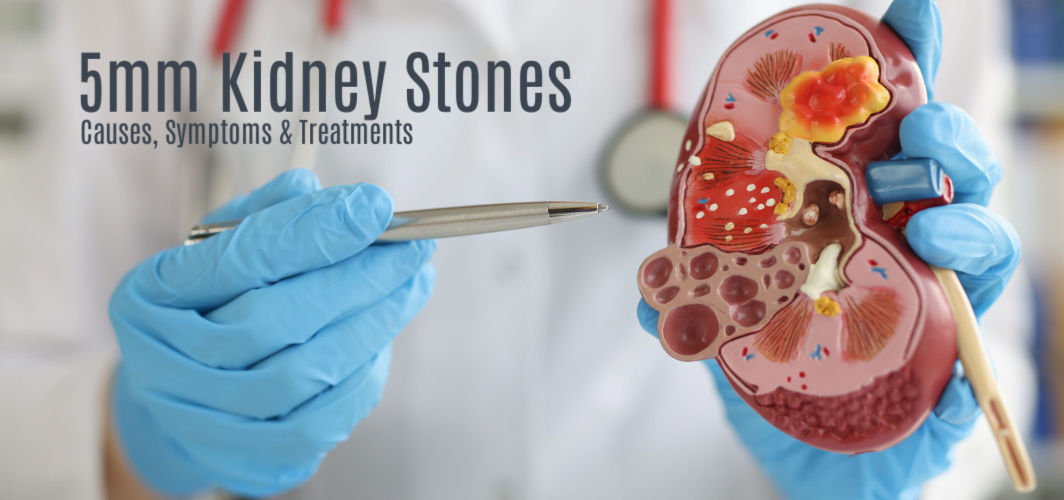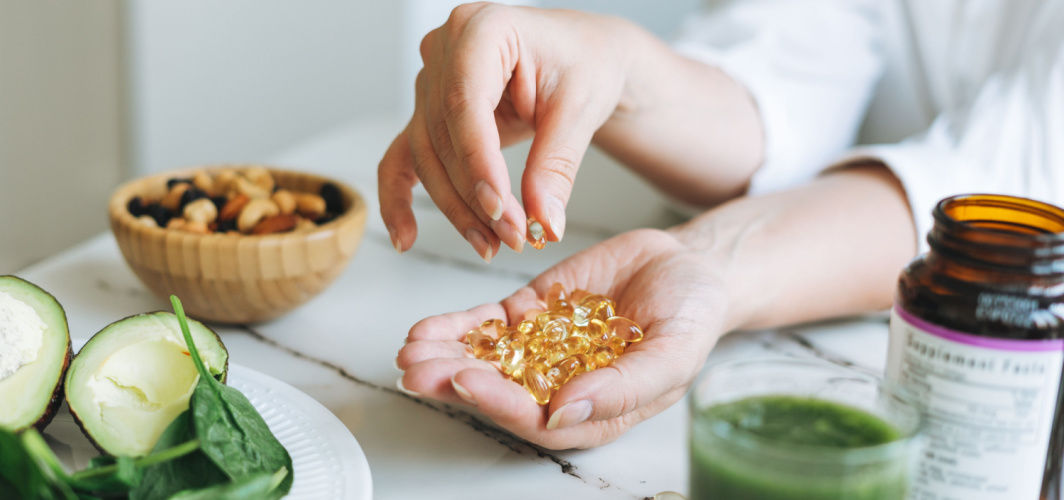General Health
Managing 5 mm Kidney Stones: Causes, Symptoms, Diagnosis & Treatment
7 min read
By Apollo 24|7, Published on - 24 August 2023, Updated on - 07 August 2024
Share this article
0
0 like

Kidney stones are mineral and salt deposits in the kidneys, also known as renal calculi. Ranging in size and composition, they can be as small as a grain of sand or as large as a golf ball. This common medical condition affects numerous people globally, including a substantial population in India. These stones induce intense pain and discomfort, significantly impacting individuals' quality of life. A 5mm kidney stone is dangerous and requires prompt attention. In this article, we'll explore the causes, symptoms, diagnosis, and treatment options for 5mm kidney stones.
Different Types of Kidney Stones
There are several types of kidney stones, each with its unique composition. The most common types include:
- Calcium Stones: Calcium Stones are the most prevalent type and are made up of calcium oxalate.
- Cystine Stones: Cystine Stones are rare and are caused by a genetic condition called cystinuria.
- Struvite Stones: Struvite Stones usually form as a result of urinary tract infections.
- Uric Acid Stones: Uric acid stones may occur in individuals with fluid loss from chronic diarrhoea or malabsorption, high-protein diets, diabetes/metabolic syndrome, and genetic factors.
Why Does the Size of the Kidney Stone Matter?
The size of a kidney stone can determine its potential impact on health and the appropriate treatment approach.
- Passage: Smaller stones, like a 5mm kidney stone, have a higher chance of passing through the urinary tract on their own. However, stones more in size than the 5mm kidney stone is dangerous as they may get stuck along the way, leading to blockages and severe pain.
- Treatment Options: Treatment for kidney stones depends on their size. Smaller stones can be managed with increased fluid intake and pain management. Larger stones may require interventions like lithotripsy or surgery.
- Complications: Larger stones pose greater risks, including severe symptoms, urinary tract infections, and kidney damage or failure if they become lodged in the urinary tract.
- Prevention: Understanding the stone size helps healthcare professionals develop personalised prevention strategies to prevent recurring stone formation.
Symptoms of a 5 mm Kidney Stone
Some specific 5mm kidney stone symptoms that may be experienced include:
- Renal Colic: Intense, cramp-like pain in the side or back, often radiating to the groin or lower abdomen.
- Hematuria: One of the 5mm kidney stone symptoms is hematuria, which is characterised by blood in the urine, which may appear pink, red or brown.
- Frequent Need to Pass Urine: Often accompanied by a burning sensation or pain during urination.
- Cloudy or Foul-smelling Urine: Due to the presence of bacteria or other substances.
- Nausea and Vomiting: Nausea and vomiting may occur due to the pain caused by kidney stones.
Diagnosis of a 5 mm Kidney Stone
Diagnosing a 5mm kidney stone involves methods such as:
1. Physical Examination and Medical History Review
During the physical examination, your healthcare provider will assess symptoms, conduct a thorough exam and review medical history, including prior kidney stones or conditions related to stone formation.
2. Imaging Tests
The commonly used imaging tests include:
- X-rays: X-ray is a non-invasive test that can help determine the size and location of the kidney stone. However, smaller stones may not always be visible on an X-ray.
- Ultrasound: Ultrasound as an imaging technique uses sound waves to create images of the kidneys and the urinary tract. It is particularly useful for detecting larger stones or those in certain kidney areas.
- CT Scans: A computed tomography (CT) scan provides detailed cross-sectional images of the kidneys and can accurately pinpoint the size and location of kidney stones, regardless of their composition.
3. Laboratory Tests
Some of the tests include:
- Urine Analysis: Urine analysis helps identify any abnormalities in the urine that may indicate the presence of a kidney stone. It can also provide information about kidney function.
- Blood Tests: Certain blood tests, such as serum creatinine levels, can help assess kidney function and determine if there are any complications associated with the kidney stone.
Causes of 5 mm Kidney Stone
Let us have a look at the 5mm kidney stone causes which include:
1. Dietary Factors
Dietary factors that can cause 5 mm kidney stones include:
- High Intake of Oxalate-rich Foods: Consuming oxalate-rich foods like spinach, beetroot, and nuts increases the risk of kidney stone development. Oxalates combined with urine calcium form crystals that contribute to stone formation.
- Dehydration and Low Fluid Intake: Inadequate fluid intake can contribute to kidney stone formation. Insufficient body fluid leads to concentrated urine, facilitating crystal formation.
- High Salt and Protein Consumption: A diet high in salt and animal protein can increase the amount of calcium and uric acid in the urine, which leads to stone formation.
2. Medical Conditions and Medications
Medical conditions and medications that can cause 5mm kidney stones include:
- Hyperparathyroidism and Other Metabolic Disorders: Conditions that affect the body's metabolism, such as hyperparathyroidism or certain genetic disorders, can increase the risk of kidney stone formation.
- Urinary Tract Infections (UTIs): UTIs can lead to the formation of struvite stones. These stones are commonly associated with bacterial infections.
- Certain Medications that Increase Stone Formation: Some medicines, such as diuretics or antacids containing calcium, can increase the risk of developing kidney stones.
5 mm Kidney Stone Treatment Options
Understanding 5mm kidney stone causes is crucial in determining the most effective treatment. The choice of treatment depends on various factors, including the location and composition of the stone and the patient's overall health. Here are some of the 5mm kidney stone treatment options:
1. Conservative Management Approaches
Conservative management approaches focus on non-invasive methods to address kidney stones. For a 5mm kidney stone treatment, these methods can include increased fluid intake and medications to facilitate stone passage.
- Hydration and Increased Fluid Intake: Drinking plenty of water can help flush out the stone from the urinary tract. Aim for at least 2-3 litres of water per day.
- Pain Management with Over-the-counter Medications: Non-steroidal anti-inflammatory drugs (NSAIDs) like ibuprofen can help relieve pain associated with kidney stones.
2. Medical Interventions for Symptom Relief and Stone Passage Facilitation
Some of the medical interventions that can be employed for 5mm kidney stone treatment are:
- Medications to Relax the Ureter Muscles and Promote Stone Passage: Alpha-blockers such as tamsulosin can help relax the muscles in the ureter, making it easier for the stone to pass.
- Extracorporeal Shock Wave Lithotripsy (ESWL): This treatment involves the use of shock waves to break the stone into smaller fragments.
3. Surgical Interventions for Larger or More Complex Stones
Surgical intervention may sometimes be necessary for larger or more complex stones. A 5mm kidney stone is dangerous and may require prompt treatment. Some medical procedures may be performed to remove or disintegrate the stone, such as:
- Ureteroscopy: Ureteroscopy surgery is a minimally invasive procedure used to remove or break down kidney stones using a small, flexible tube inserted through the urethra and bladder.
- Percutaneous Nephrolithotomy: Percutaneous nephrolithotomy involves accessing the kidney through a small incision in the back to remove or break down large kidney stones.
Prevention of 5 mm Kidney Stone Recurrence
Kidney stones can be painful and a recurrent problem if not managed effectively. Here are some key strategies that can help:
1. Dietary Modifications and Fluids
Adjusting your diet can play a crucial role in preventing 5 mm kidney stone formation.
- Limit consumption of foods high in oxalate, such as spinach and chocolate, as they can contribute to stone formation.
- Reduce sodium intake to less than 2,300 mg per day to prevent calcium buildup in the kidneys.
- Maintain a balanced diet that includes adequate fibre, fruits, and vegetables to promote overall kidney health.
2. Medications to Prevent Stone Formation
Based on the type of stone, your doctor may prescribe medications to reduce the risk of recurrence.
- Medications such as thiazide diuretics or citrate supplements may be prescribed to reduce the formation of certain categories of kidney stones.
- These medications work by altering the chemical composition of urine or reducing the concentration of stone-forming substances.
3. Lifestyle Changes to Reduce the Risk of Future Stones
Adopting healthy lifestyle habits can significantly lower the risk of future 5mm kidney stones.
- Regular physical activity can help maintain a healthy weight and reduce the risk of stone formation.
- Quit smoking, as it can increase the risk of developing 5mm kidney stones.
- Limit alcohol consumption, as excessive alcohol intake can lead to dehydration and increase the risk of stone formation.
In conclusion, a 5 mm kidney stone can result from multiple factors such as dehydration, diet, and medical conditions. Its symptoms can be alleviated through medication and lifestyle changes. It is important to seek medical advice if you suspect you have a 5mm kidney stone, as early diagnosis and appropriate treatment can help prevent complications and manage the condition effectively.
General Health
Consult Top Nephrologists
View AllLeave Comment
Recommended for you

General Health
Blood Cancer: Types, Causes, Symptoms, Diagnosis, Treatment
Blood cancer like leukemia & lymphoma leads to an increase in abnormal blood cells, which hinder your body from performing its regular function and can be life-threatening. There is no cure for cancer but there are several ways to treat it.

General Health
5 Important Vaccines That Young Adults Must Not Skip
Vaccines aid in the development of immunity and provide protection against some serious diseases. As a child, you might have received many vaccinations, but as adults, there are a few vaccines that you must not skip.

General Health
What Are The Symptoms Of Vitamin D Deficiency?
Vitamin D is important for a healthy functioning of the body. Discover effective preventative methods, like sun exposure, dietary changes, and supplements that can help prevent vitamin D deficiency. This blog is a guide to help you know about vitamin D deficiency symptoms, causes and more.
Subscribe
Sign up for our free Health Library Daily Newsletter
Get doctor-approved health tips, news, and more.
Visual Stories

The Best Exercises for Controlling Blood Sugar Levels
Tap to continue exploring
Recommended for you

General Health
Blood Cancer: Types, Causes, Symptoms, Diagnosis, Treatment
Blood cancer like leukemia & lymphoma leads to an increase in abnormal blood cells, which hinder your body from performing its regular function and can be life-threatening. There is no cure for cancer but there are several ways to treat it.

General Health
5 Important Vaccines That Young Adults Must Not Skip
Vaccines aid in the development of immunity and provide protection against some serious diseases. As a child, you might have received many vaccinations, but as adults, there are a few vaccines that you must not skip.

General Health
What Are The Symptoms Of Vitamin D Deficiency?
Vitamin D is important for a healthy functioning of the body. Discover effective preventative methods, like sun exposure, dietary changes, and supplements that can help prevent vitamin D deficiency. This blog is a guide to help you know about vitamin D deficiency symptoms, causes and more.

